Did the Reds handle Mike Leake’s service time correctly?

Mike Leake returns to Great American Ball Park tonight as the Cardinals starter. What if he hadn’t started his career in the majors?
This year, there has been a lot of talk about service time and Super Two with the Reds, especially with their four top prospects of Jose Peraza, Robert Stephenson, Cody Reed, and Jesse Winker, who are all in Triple-A despite being major-league ready. For the most part, this is because the Reds wanted to avoid them reaching 172 days of service on the MLB roster (or one season), which would keep them under team control through at least 2022 and at the same time avoid them reaching Super Two status. By avoiding Super Two status, the players would not be eligible for arbitration until after the 2019 season.
While most agree that is a good idea when the Reds chances of contending are very low, another argument popped up as well. If the Reds would have done the same thing with Mike Leake in 2010 he would still be here today. Like most things, when looking through the prism of hindsight, there are a number of things missed.
Here are three reasons why Leake not starting his career in the minors was a good thing both then and now.
First, if Leake doesn’t start the 2010 season in the majors, the Reds likely do not win the divisional championship. The Reds’ 2010 campaign started out rough, going 12-11 in April and starting May, five games out of first place at one game under .500. The bright spot in that time period was Mike Leake, who went 4-0 in his first seven starts. The Reds were 6-1 in those same games. Leake kept the Reds hovering around .500 before they truly turned on the winning streak. Leake was a major reason they were able to turn things around that season, not losing his first game until June 16th in his 13th start. He would go on to have an 8-4 record in 22 starts that season, with an ERA of 3.78 as a starter.
More from Reds News
- Reds: 3 players Cincinnati must find trade partners for this offseason
- Reds vs. Nationals: Pitching preview, prediction, and more
- Reds: David Bell’s new contract was the right move at the wrong time
- Reds: Multi-run innings have hurt Michael Lorenzen this season
- Reds fan bares all in fulfilling awkward 2021 World Series bet
Secondly, 2010 was a much different year for the Reds. While they weren’t picked to win the division that year, the team and fans expected that 2010 would be the year they finally broke the drought of nearly a decade of losing seasons. 2010 was a year when the Reds were looking to win now and, in that case, you have to go with the best 25 men to start the season, regardless of service time considerations. Also, Leake was never projected to be a top-of-rotation starter, so the risk of a first-year arbitration salary of $6 to $9 million was very low.
Finally, looking at the 2016 season, had the Reds kept the service time to where Leake was still under team control for 2016, one of the bright spots of this season would not be here. Adam Duvall was acquired by the Reds for Leake. That trade doesn’t happen if there is another year of control, as either the Reds would have kept him or his value would have been perceived to be higher and Duvall would not have been part of that trade. Leake also would have been making a ridiculous amount of money for a non-ace pitcher on a non-contending team. Having a power bat left fielder for up to six more years is a much better deal than a middle-of-a-rotation starter at a high dollar contract for a middle revenue team.
Next: Who could the Reds take with the No. 2 pick?
I enjoyed watching Mike Leake when he was here, but the Reds made all the right moves regarding his service time. So far, the trade looks to be a great one with the Reds, as Adam Duvall is starting to show his full potential as a major league bat and outfielder.